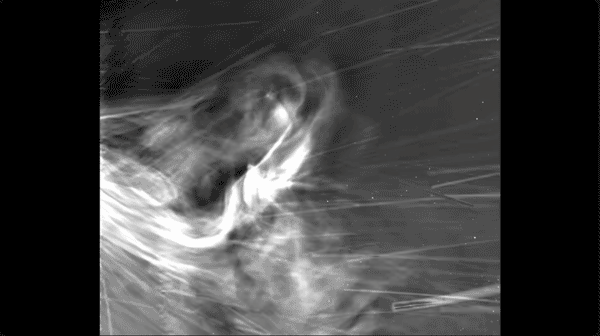
Cameras on the ground need strong solar filters to photograph things like an eclipse, yet NASA has made a camera that was capable of flying through the sun’s corona without melting – and it just published its first close-up images.
The Parker Solar Probe passed through the sun’s corona late last year, coming within 3.8 million miles from the surface of the sun. While NASA has shared images from the solar probe before, the close flight enabled Parker to capture the closest ever photos and videos of the sun, shared earlier this month.
The imager on board Parker is the Wide-Field Imager, or WISPR. During that closest-ever pass through the sun’s corona, WISPR captured video of both the corona and solar wind, along with collecting data on Parker’s array of different instruments.
The resulting footage is a mesmerizing black-and-white video of dancing solar wind and flying particles.
While photographers and videographers on the ground won’t be able to take the same sort of photos that Parker can, the data from the close fly-by could end up benefiting earth-dwelling creatives as well as astronauts. The data is helping researchers better understand the impact of solar winds by studying them at their source rather than from a distance.
A greater understanding of the solar winds can help researchers find ways to enhance astronaut safety, as well as enhance space weather safety for satellites and other technology affected by solar storms.
But the solar winds captured by WISPR also enable researchers to study the cause of the aurora at its source. The solar winds, along with other “outbursts” from the sun and magnetic currents, are what create auroras. Perhaps a better understanding of solar winds could even improve aurora predictions? An astrophotographer can hope!
The resulting video is already building on scientists' understanding of coronal mass ejections, or CMEs. Colliding CMEs will change trajectory, NASA says, so being able to observe these collisions could help scientists better predict space weather influenced by these CMEs.
Since the probe’s launch in 2018, the Parker Solar Probe has already helped scientists gain a better understanding of the sun. For example, while solar wind appears like a constant wind on Earth, Parker showed that it’s anything but on the sun due to zig-zagging magnetic fields called switchbacks. Parker also discovered that the boundary of the corona wasn’t as even as scientists first believed.
Parker’s instruments, including the WISPR imaging, are protected using a custom heat shield. While the probe travels close enough to the sun to see temperatures in the millions, the low density of the corona means NASA “only” had to design a heat shield to withstand around 2,500°F / 1,400°C (which is still hotter than hot lava).
Parker’s latest capture of the solar winds is fitting, as the solar probe was named after the heliophysicist Eugene Parker, the first to theorize about solar winds in the late 1950s.
You may also like
Browse the best lenses for astrophotography or the best solar filters.







